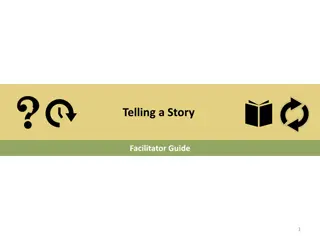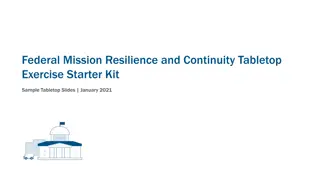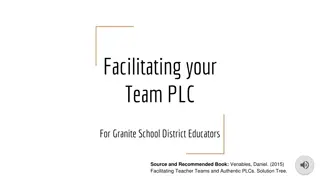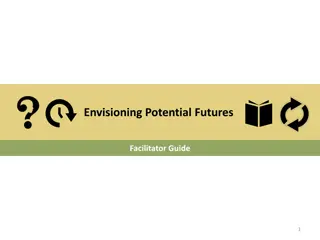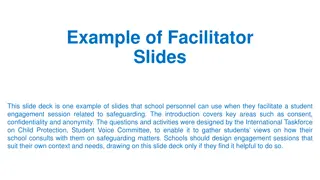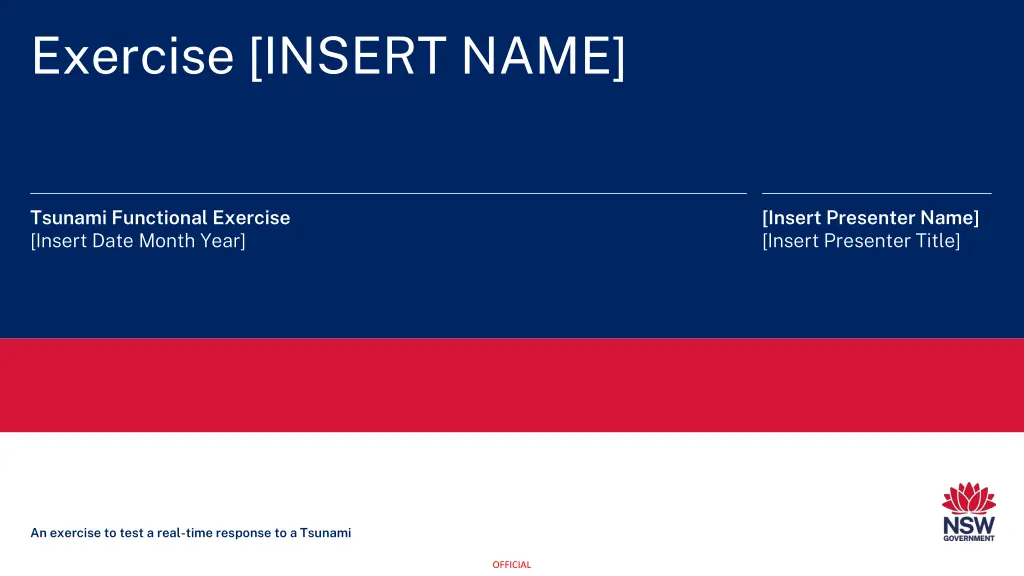
Real-Time Tsunami Response Functional Exercise Overview
Explore the details of an official functional exercise designed to assess the real-time response capabilities to a simulated tsunami emergency. Dive into the objectives, agenda, housekeeping, introductions, evaluation process, and more in this comprehensive briefing.
Download Presentation

Please find below an Image/Link to download the presentation.
The content on the website is provided AS IS for your information and personal use only. It may not be sold, licensed, or shared on other websites without obtaining consent from the author. If you encounter any issues during the download, it is possible that the publisher has removed the file from their server.
You are allowed to download the files provided on this website for personal or commercial use, subject to the condition that they are used lawfully. All files are the property of their respective owners.
The content on the website is provided AS IS for your information and personal use only. It may not be sold, licensed, or shared on other websites without obtaining consent from the author.
E N D
Presentation Transcript
OFFICIAL Exercise [INSERT NAME] Tsunami Functional Exercise [Insert Date Month Year] [Insert Presenter Name] [Insert Presenter Title] An exercise to test a real-time response to a Tsunami OFFICIAL
OFFICIAL Acknowledgement of Country I acknowledge the Traditional Custodians of the lands that we are meeting here today. I pay my respects to Elders past, present and emerging and celebrate the diversity of Aboriginal peoples and their ongoing cultures and connections to the lands and waters of NSW. I also acknowledge and pay my respects to our Aboriginal and Torres Strait Islander people/colleagues joining us today. 2 OFFICIAL
OFFICIAL Agenda Briefing and introduction Exercise purpose Expectations and objectives Context (including outline of EM arrangements if required) Scenario General idea (background) Review Discoveries What went well What could be done differently 3 OFFICIAL
OFFICIAL Housekeeping Emergencies Toilets Mobile phones and other devices Morning tea, lunch and afternoon tea provided. No set breaks for meals as participants required to manage breaks as part of exercise. 4 OFFICIAL
OFFICIAL Introductions My name is My day-to-day role is My likely role in an emergency will be 5 OFFICIAL
OFFICIAL Evaluation process The purpose of evaluation of the exercise is to assess if, and to what extent, the exercise met the aim and objectives of the exercise. Data and observations will be gathered during and after the exercise using the following tools: Participant Feedback Form After-Action Review Debrief Forms Evaluator s Observation Checklist Upon completing the exercise, evaluators will return all completed data collection tools to the Exercise Evaluation Coordinator. The Coordinator will then compile and analyse the collected data and observations, documenting insights and lessons in the analysis tables within the Evaluation Plan. The final exercise and evaluation reports are to be submitted to the Premier s Department and will contribute to the annual State Lessons Analysis process. 6 OFFICIAL
OFFICIAL Exercise Briefing This is an exercise. Any images are historical and may be from another place. OFFICIAL
OFFICIAL Aim and objectives Aim: To test the real-time response of the LEMC/REMC to a simulated tsunami emergency, in order to evaluate the committee's readiness, preparedness, and capability to manage the hazard effectively. Objectives: 1 - Ensure that the LEMC/REMC has procedures in place for managing tsunamis. 2 - Evaluate the adaptability and flexibility of LEMC/REMC team members in responding to challenging or unexpected developments during the exercise. 3 - Verify that the structure of any activated organisation (e.g., EOC) aligns with procedures and is logical, clearly structured, and communicated to all involved. 4 - Evaluate participants' knowledge and awareness of emergency management, hazard specific and EOC procedures. 5 - Assess participants' knowledge, skills, and abilities in operating within an EOC. 6 - Evaluate the effectiveness of decisions and actions in response to challenging and complex scenarios. 7 - Assess the suitability and adequacy of facilities, venues, and resources available during the exercise. 8 - Identify knowledge, skill, and capability gaps among LEMC/REMC members and develop action plans to address these gaps. 9 - Test interagency communication and coordination during the response. 8 OFFICIAL
OFFICIAL Background Time 09:30, 3 March A series of major undersea earthquakes west of the Tonga Trench, approximately 850 km south of Fiji, has raised the potential for a significant tsunami threat to the entire east coast of Australia. The first earthquake, with a magnitude of 8.9, occurred at approximately 07:34 and was detected by Geoscience Australia. At 07:40, an official tsunamigenic earthquake notification was issued. In the hours immediately following the quake, tsunami waves began impacting Fiji, Tonga, and New Caledonia. Initial reports indicate severe coastal inundation, widespread damage, and a high number of casualties. 9 OFFICIAL
OFFICIAL Background Time 09:30, 3 March News of the earthquake and the potential tsunami threat to Australia quickly reaches local and national media, spreading rapidly through the community. At 07:51, the Joint Australian Tsunami Warning Centre (JATWC) issues a National Tsunami Watch Bulletin. This is followed at 08:21 by a Tsunami Land Threat Warning, indicating major inundation of low-lying coastal areas along the entire east coast of Australia. The warning predicts impact at approximately 14:00 and advises residents in low-lying coastal areas to take shelter on high ground above 10 metres or move at least 1 km inland from the coast. 10 OFFICIAL
OFFICIAL Background Time 09:30, 3 March In response, the NSW State Emergency Service (SES) initiates preparations for a major incident, recalling Incident Management Team (IMT) staff and activating Zone and State Incident Command Centres. By this time, many residents have already begun to self-evacuate in haste, leading to significant congestion on roads and designated evacuation routes as people attempt to move inland. Emergency services are quickly overwhelmed with requests for information and assistance. Local and Regional Emergency Operations Controllers, acting on advice from the SES, activate Operations Centres (EOCs) across the potential impact zones. The EOCs are tasked with managing community impacts and supporting the SES in preparation for the anticipated tsunami impact. At 08:45, the first notifications are sent to LEMC/REMC liaisons, functional area and supporting agency delegates, advising them of official EOC activations across the threat zones. local and regional Emergency 11 OFFICIAL
OFFICIAL Background Time 09:30, 3 March With the available intelligence, the EOCs must rapidly establish themselves and begin supporting the combat agency IMT through the warning, impact, and very early recovery phases of the emergency. Teams will need to respond dynamically to official updates and adapt to evolving challenges in real time. 12 OFFICIAL
OFFICIAL Review 1. Please complete the feedback sheet 2. In your group, please identify: Three things you discovered or surprised you Three things that work well Three things you would do differently Any questions you want answered before you leave 13 OFFICIAL
OFFICIAL OFFICIAL








